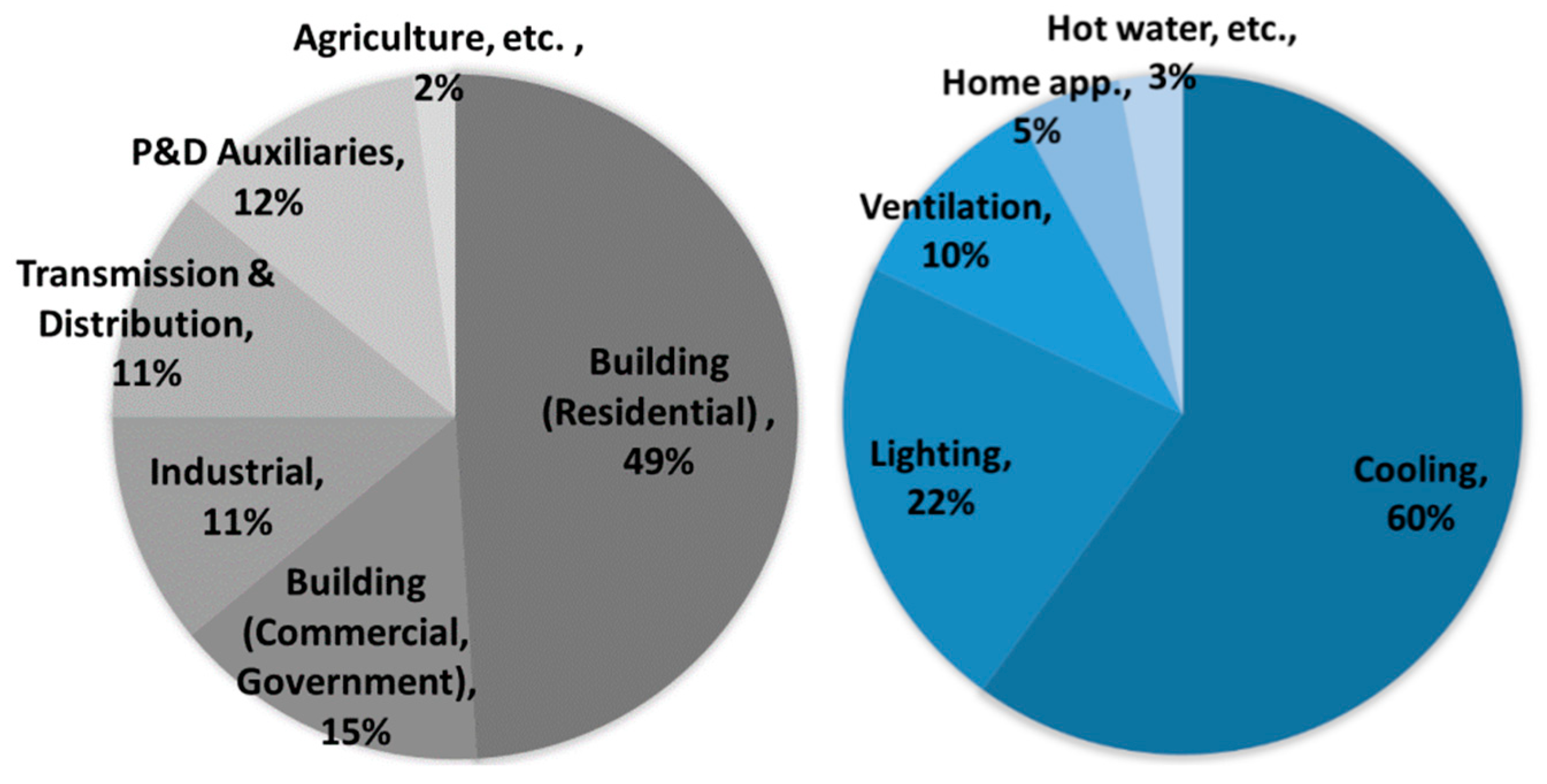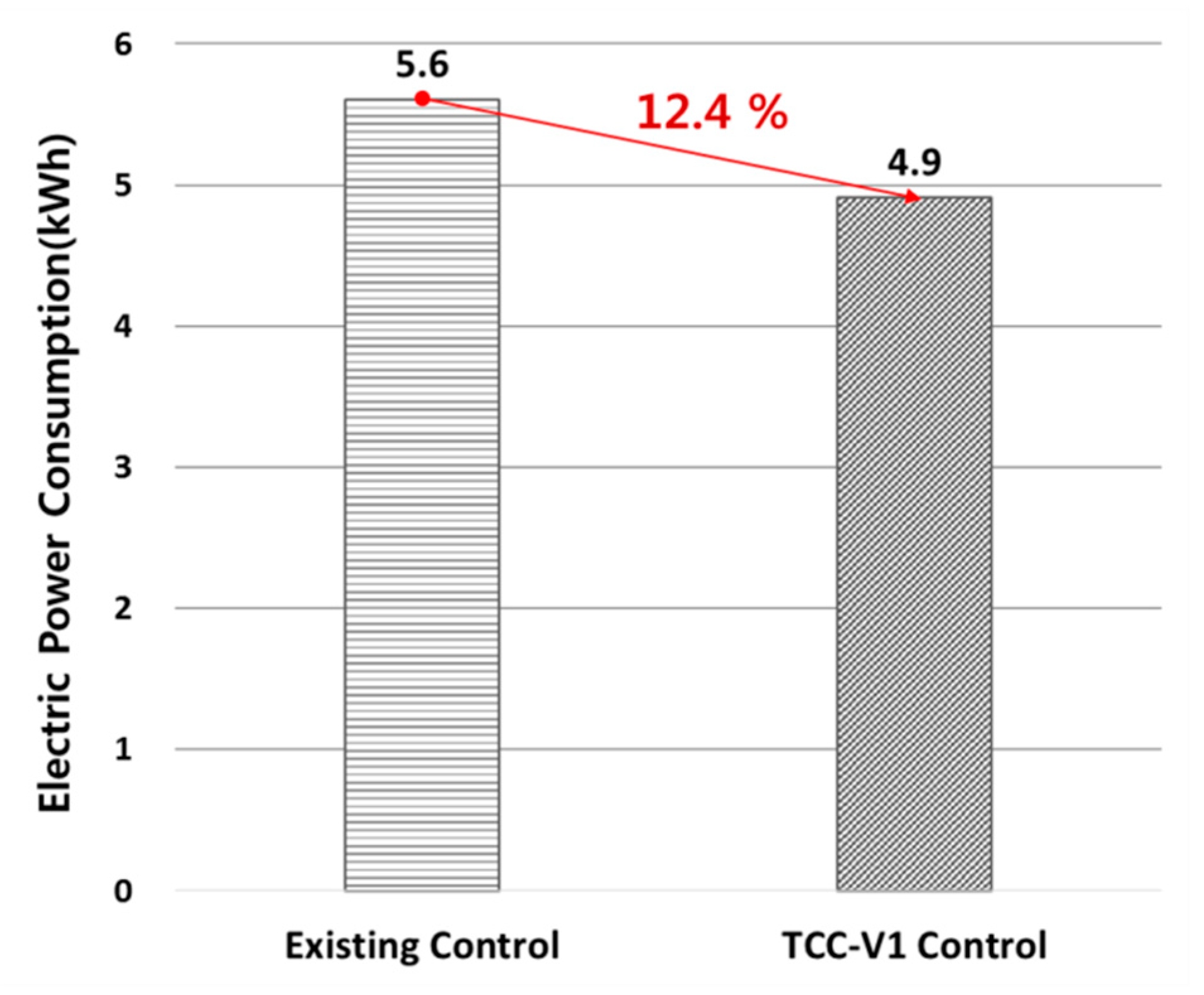Development of Thermal Comfort-Based Controller and Potential Reduction of the Cooling Energy Consumption of a Residential Building in Kuwait
Abstract
:1. Introduction
1.1. Background and Objective
1.2. Previous Work
2. Energy Saving Potential of Thermal Comfort-Based Control
2.1. Establishment of a Simulation Model
2.2. Calibration of Simulation Model
2.3. Implementation of Simulation and Result Analysis
3. Development of Thermal Comfort-Based Controller
3.1. Sensitivity Analysis of Variables
3.2. Development of Controller and Composition
- Controller: the core of the TCC-V1. The controller computes the PMV index and the target temperature in real time based on data collected by the sensors.
- Communication device: enables communication between the controller and the AC unit.
- Monitoring device: confirms controller computational results by sending data to the controller. Although this function can be performed by the controller, the monitoring device acts as a data backup.
- Sensors: measure temperature, humidity and whether the room is occupied and then sends the data to the controller.
4. Experimental Performance Evaluation of TCC-V1
4.1. Experimental Scope and Method
- Develop the TCC-V1 device such that it can compute the appropriate target temperature to maintain occupant comfort by iteratively computing the real-time PMV and communicate with the AC accordingly.
- Use the analysis of the meteorological data of Kuwait to select a representative day from the summer (May–September), the intermediate seasons (March, April, October, and November), and winter (December–February).
- Install an inner chamber containing the AC and TCC-V1 device to mimic a residential house for one or two people inside of a real-scale climatic environment chamber (outer chamber in Figure 15).
- Set the climatic condition (the temperature and humidity on each selected representative day) in the outer chamber and evaluate and compare the corresponding AC electric energy consumption according to the AC control with and without the TCC-V1 device.
4.2. Experimental Weather Conditions
4.3. Climatic Environment Chamber
4.4. Manufacturing and Installing the Experimental Chamber
5. Results and Discussion
5.1. Summer Season—August 10
5.2. Intermediate Season—October 17
5.3. Winter Season—January 8
6. Conclusions
- On August 10, a representative day of the summer season, the TCC-V1 reduced the electric energy consumption by 39.5% and the PMV was improved from −1.21 to 0.06.
- On October 17, a representative day of the intermediate season, the TCC-V1 reduced the electric energy consumption by 12.4% and the PMV was improved from −1.15 to −0.28.
- The results of the experiment conducted on January 8, a representative day of the winter season, showed that the AC was not in operation because the indoor temperature of the inner chamber was always below the setpoint temperature of the AC unit.
Author Contributions
Funding
Conflicts of Interest
Nomenclature
| AC | Air conditioner |
| ASHRAE | American society of heating, refrigerating and air-conditioning engineers |
| CAV | Constant air volume |
| CLO | Cloth value of people |
| CV-RMSE | Coefficient of variation of root mean-squared error |
| DOE | Department of energy |
| HVAC | Heating, ventilation and air conditioning |
| MBE | mean bias error |
| MET | Metabolic rate of people |
| MEW | Ministry of energy and water |
| MPC | Model predictive control |
| MRT | Mean radiant temperature |
| PMV | Predicted mean vote |
| RCEC | Real-scale climatic environment chamber |
| RH | Relative humidity |
| TCC | Thermal comfort-based controller |
| TMY | Typical meteorological year |
References
- Kondratyev, K.Y.; Varotsos, C. Atmospheric greenhouse effect in the context of global climate change. Nuovo Cim. C 1995, 18, 123–151. [Google Scholar] [CrossRef]
- Cao, X.; Dai, X.; Liu, J. Building energy-consumption status worldwide and the state-of-the-art technologies for zero-energy buildings during the past decade. Energy Build. 2016, 128, 198–213. [Google Scholar] [CrossRef]
- Hassan, R.J.; Zin, R.M.; Majid, M.A.; Balubaid, S.; Hainin, M.R. Building Energy Consumption in Malaysia: An Overview. J. Teknol. 2014, 707, 2180–3722. [Google Scholar] [CrossRef]
- Ministry of Electricity and Water. Available online: https://www.mew.gov.kw/ (accessed on 13 April 2019).
- Jaffar, B.; Oreszczyn, T.; Raslan, R. Empirical and modelled energy performance in Kuwaiti villas: Understanding the social and physical factors that influence energy use. Energy Build. 2019, 188–189, 252–268. [Google Scholar] [CrossRef]
- Al-Mumin, A.; Khattab, O.; Sridhar, G. Occupants’ behavior and activity patterns influencing the energy consumption in the Kuwaiti residences. Energy Build. 2003, 35, 549–559. [Google Scholar] [CrossRef]
- Ameer, B.; Krarti, M. Impact of subsidization on high energy performance designs for Kuwaiti residential buildings. Energy Build. 2016, 116, 249–262. [Google Scholar] [CrossRef]
- Kellow, M. Kuwait’s approach to mandatory energy-conservation standards for buildings. Energy 1989, 14, 491–502. [Google Scholar] [CrossRef]
- Han, D.; Li, R.; Wang, F.; Sun, Z.; Moon, S.; Gong, Z.; Yu, W.; Zhang, Y. Study on Indoor Thermal Environment Control Based on Thermal Sensation Prediction. Procedia Eng. 2017, 205, 3072–3079. [Google Scholar] [CrossRef]
- Sadineni, S.B.; Boehm, R.F. Measurements and simulations for peak electrical load reduction in cooling dominated climate. Energy 2012, 37, 689–697. [Google Scholar] [CrossRef]
- Li, W.; Zhang, J.; Zhao, T. Indoor thermal environment optimal control for thermal comfort and energy saving based on online monitoring of thermal sensation. Energy Build. 2019, 197, 57–67. [Google Scholar] [CrossRef]
- Fanger, P.O. Calculation of Thermal Comfort—Introduction of a Basic Comfort Equation. ASHRAE Trans. 1967, 73, III4.1–III4.20. [Google Scholar]
- Shaw, E.W. Thermal Comfort: Analysis and applications in environmental engineering, by P. O. Fanger. 244 pp. DANISH TECHNICAL PRESS. Copenhagen, Denmark, 1970. Danish Kr. 76, 50. R. Soc. Health J. 1972, 92, 164. [Google Scholar] [CrossRef]
- Conceição, E.Z.E.; Gomes, J.M.M.; Ruano, A.E. Application of HVAC Systems with Control Based on PMV Index in University Buildings with Complex Topology. IFAC-PapersOnLine 2018, 51, 20–25. [Google Scholar] [CrossRef]
- Yan, H.; Niu, J.; Deng, S. A Thermal Comfort based Controller for a Direct Expansion Air Conditioning System. Energy Procedia 2017, 142, 1817–1822. [Google Scholar] [CrossRef]
- Yan, H.; Pan, Y.; Li, Z.; Deng, S. Further development of a thermal comfort based fuzzy logic controller for a direct expansion air conditioning system. Appl. Energy 2018, 219, 312–324. [Google Scholar] [CrossRef]
- Goyal, S.; Ingley, H.A.; Barooah, P. Occupancy-based zone-climate control for energy-efficient buildings: Complexity vs. performance. Appl. Energy 2013, 106, 209–221. [Google Scholar] [CrossRef]
- Goyal, S.; Ingley, H.A.; Barooah, P. Zone-level control algorithms based on occupancy information for energy efficient buildings. In Proceedings of the 2012 American Control Conference (ACC), Montreal, QC, Canada, 27–29 June 2012; pp. 3063–3068. [Google Scholar]
- Park, J.Y.; Nagy, Z. Comprehensive analysis of the relationship between thermal comfort and building control research—A data-driven literature review. Renew. Sustain. Energy Rev. 2018, 82, 2664–2679. [Google Scholar] [CrossRef]
- Coakley, D.; Raftery, P.; Keane, M. A review of methods to match building energy simulation models to measured data. Renew. Sustain. Energy Rev. 2014, 37, 123–141. [Google Scholar] [CrossRef] [Green Version]
- Royapoor, M.; Roskilly, T. Building model calibration using energy and environmental data. Energy Build. 2015, 94, 109–120. [Google Scholar] [CrossRef] [Green Version]
- Ahmad, M.; Culp, C.H. Uncalibrated Building Energy Simulation Modeling Results. HVAC R Res. 2006, 12, 1141–1155. [Google Scholar] [CrossRef]
- Clarke, J. Energy Simulation in Building Design, 2nd ed.; Butterworth-Heinemann: Oxford, UK, 2001; pp. 1–21. ISBN 0-7506-5082-6. [Google Scholar]
- Strachan, P.A.; Kokogiannakis, G.; Macdonald, I.A. History and development of validation with the ESP-r simulation program. Build. Environ. 2008, 43, 601–609. [Google Scholar] [CrossRef] [Green Version]
- ASHRAE Guideline 14-2014: Measurement of Energy, Demand, and Water Savings. Available online: https://webstore.ansi.org/standards/ashrae/ashraeguideline142014 (accessed on 30 August 2019).
- Hawila, A.A.-W.; Merabtine, A.; Chemkhi, M.; Bennacer, R.; Troussier, N. An analysis of the impact of PMV-based thermal comfort control during heating period: A case study of highly glazed room. J. Build. Eng. 2018, 20, 353–366. [Google Scholar] [CrossRef]
- ASHRAE Standard 55-2017: Thermal Environmental Conditions for Human Occupancy; ASHRAE: Atlanta, GA, USA, 2017.
- Lu, S.; Wang, W.; Lin, C.; Hameen, E.C. Data-driven simulation of a thermal comfort-based temperature set-point control with ASHRAE RP884. Build. Environ. 2019, 156, 137–146. [Google Scholar] [CrossRef]
- Wang, J.; Wang, Z.; de Dear, R.; Luo, M.; Ghahramani, A.; Lin, B. The uncertainty of subjective thermal comfort measurement. Energy Build. 2018, 181, 38–49. [Google Scholar] [CrossRef]























| Items | Contents | Remarks | Exterior View |
|---|---|---|---|
| Location | Aqaila, Kuwait | Single Family (6 people) |  |
| Completion | 2013 | - | |
| Stories | 4 floors | - | |
| Structure | R.C. | R.C., Cement Block, Fiber Glass, Cement Mortar | |
| Plot Area | 375 m2 | - | |
| Gross Area | 879.22 m2 | - | |
| Gr. Floor Area | 319.75 m2 | 2 Reception Areas, Swimming Pool | |
| 1st Floor Area | 255.12 m2 | Living Room, Kitchen, Dining Room, Study, Theater | |
| 2nd Floor Area | 255.12 m2 | 1 Master Bedroom, 3 Bedrooms, Kitchen | |
| 3rd Floor Area | 70.7 m2 | Maid’s Room, Laundry Room |
| Manual Control by Occupant | Thermal Comfort Based Control |
|---|---|
 |  |
| Items | Without TCC-V1 | With TCC-V1 |
|---|---|---|
| AC Temperature setpoint | August 10: 18 °C | Automatically set |
| October 17: 21 °C | ||
| January 8: 23 °C | ||
| Input data (fixed value) | CLO: 0.5 (August 10 and October 17), 1.0 (January 8) | |
| MET: 90 W/m2 | ||
| Air velocity: 0.09 m/s | ||
| Measurement Value | Real-time AC electric energy consumption | |
| Air temperature and RH of inner and outer chamber | ||
| AC temperature setpoints controlled by TCC-V1 | ||
| PMV index | ||
| Items | Summer Season | Intermediate Season | Winter Season | |||
|---|---|---|---|---|---|---|
| Period | May–September | March, April, October, and November | December–February | |||
| Representative date | August 10 | October 17 | January 8 | |||
| Average temperature and RH | Temp. | RH | Temp. | RH | Temp. | RH |
| 37.58 °C | 12.5% | 26.18 °C | 11.67% | 13.10 °C | 59.46% | |
| Internal volume | 10 m × 10 m × 4.5 m |  |
| Temperature | −30–80 °C | |
| Humidity | 10–90% | |
| Insolation | 800–1200 W/m2 | |
| HVAC system | 530 m3/minute | |
| Cooling system | 123 kW | |
| Heating system | 240 kW | |
| Rainfall | each module set of 150, 40 and 25 mm/h | |
| Snowfall | 50 mm/h through movable gun |
© 2019 by the authors. Licensee MDPI, Basel, Switzerland. This article is an open access article distributed under the terms and conditions of the Creative Commons Attribution (CC BY) license (http://creativecommons.org/licenses/by/4.0/).
Share and Cite
Park, J.; Kim, T.; Lee, C.-s. Development of Thermal Comfort-Based Controller and Potential Reduction of the Cooling Energy Consumption of a Residential Building in Kuwait. Energies 2019, 12, 3348. https://doi.org/10.3390/en12173348
Park J, Kim T, Lee C-s. Development of Thermal Comfort-Based Controller and Potential Reduction of the Cooling Energy Consumption of a Residential Building in Kuwait. Energies. 2019; 12(17):3348. https://doi.org/10.3390/en12173348
Chicago/Turabian StylePark, Jaesung, Taeyeon Kim, and Chul-sung Lee. 2019. "Development of Thermal Comfort-Based Controller and Potential Reduction of the Cooling Energy Consumption of a Residential Building in Kuwait" Energies 12, no. 17: 3348. https://doi.org/10.3390/en12173348
APA StylePark, J., Kim, T., & Lee, C.-s. (2019). Development of Thermal Comfort-Based Controller and Potential Reduction of the Cooling Energy Consumption of a Residential Building in Kuwait. Energies, 12(17), 3348. https://doi.org/10.3390/en12173348




